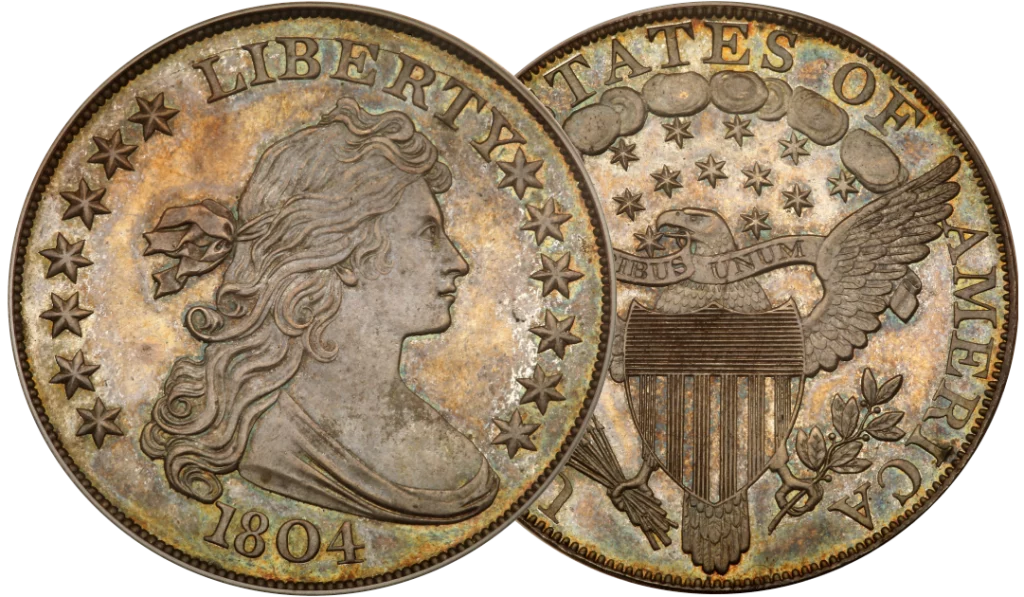
Class 1 1804 Dollars:The Epitome of United States Dollars |
|
Written by Elliot Eng The 1804 Silver Dollar has long been considered the “King of American Coins,” but the reasons behind its mintage is not only representative of United States coinage, it also accurately represents coins globally. Although three classes of 1804 Silver Dollars exist, the Class 1 1804 Silver Dollars best explain the allure of collecting coins. In the early nineteenth century, the young United States faced an economic problem. While the United States was trying to establish itself as a legitimate country on the international stage, it was also facing a national coinage crisis. Newly-minted dollars were being shipped as silver bullion to China without circulating in the U.S. After being tipped off by politicians, Mint Director Elias Boudinot ceased silver dollar production in March, 1804, while Secretary of State James Madison officially stopped production of silver dollars two years later. Because of a small financial budget, during the previous three months that dollars were minted, the mint in 1804 reused the dies from 1803 to strike 19,570 silver dollars. These silver dollars were listed in Boudinot’s mint report, which would later prove key to the legendary 1804 dollars’ existence. By 1834, United States’ silver dollars had long since been a thing of the past, only circulating in pockets of the western territories. That fall, the young United States of America was finalizing treaties with major Asian trading powers, including Siam (modern day Thailand) and Muscat (Oman). The ambassador, Edmund Roberts, feared that the diplomatic gifts he had procured would be inadequate, thus insulting the rulers of the trading powers. In a letter dated October 8, 1834, to the Department of State, Roberts expressed his unrest and stated that he felt a Morocco leather case with all of the U.S. coinage would be presentable to most Asian rulers. On November 11, 1834, Secretary of State John Forsythe, on behalf of President Andrew Jackson, asked Mint Director Samuel Moore to mint two complete sets of current U.S. coinage in a Morocco leather case. The letter was rather vague regarding which coins to include in the set, so Samuel Moore consulted Adam Eckfeldt, the chief coiner of the U.S. Mint and an accomplished collector. The ban on silver dollar production had been lifted in 1831, but none had officially been minted since then. After concluding that silver dollars were “current” coinage and should be included in the presentation sets, Eckfeldt consulted the United States Mint archives. He found former Mint Director Boudinot’s reports for the first quarter of 1804 and found that 19,570 dollars had been minted in the early part of the year. Eckfeldt, not wanting to enrage the increasing number of collectors by making a new “key” date, advised Moore to strike the dollars with the 1804 date. If he had researched further he would have found others’ observations that there were no 1804 dated dollars, such as the German Duke Bernhard’s book, Travels Through North America, During the Years 1825 and 1826, which clearly stated that no 1804 dated dollars existed. Four 1804 dollars were minted for inclusion in Robert’s presentation sets, while eight specimens of the die pairing are known in total. Eckfeldt ordered a new pair of dies for the coins, as, if there had been dies dated 1804, they would have been cracked and rusted. The Draped Bust, Heraldic Eagle reverse design was utilized. The coins’ edge was hand-lettered with the value, “HUNDRED CENTS ONE DOLLAR OR UNIT.” Four of the eight dollars were put in their sets and delivered to the Roberts’ ship on April 27, 1835. Tragically, Roberts died on June 12, 1836 after presenting the first two sets to the King of Siam and the Sultan of Muscat; his other gifts were returned to the Department of State. The presentation sets were returned to the mint. Virtually nobody but a few mint workers and high ranking officials knew about the coins. That was about to change. The subject of dollars struck in 1804 had become contentious in the numismatic community soon after their alleged striking in 1804, but there weren’t any known specimens by the early 1840’s. However, in 1842, two former mint workers published a book, A Manual of Gold and Silver Coins of All Nations. The book contained a pantograph reproduction of a Class 1 1804 Dollar. This incited rumors that were confirmed when Matthew Stickney, an accomplished collector, traded a unique gold Immune Columbia piece for the first of the six remaining dollars on May 9, 1843. One piece was assayed and then placed in the Mint Cabinet Collection, while the others were quickly sold to prominent collectors. Class 1 Silver Dollars are truly a large piece of American history, but the principles on which they were struck applies to much more than American coins. Class 1 1804 Dollars can easily represent numismatics as a whole. Coins can be used as currency, as represented by the well-worn Cohen 1804 Dollar, or as high-profile gifts, such as the nearly-perfect Siam example. Coins can represent liberty, as does the obverse of 1804 Dollars, but coins can also enslave people to their love of numismatics, as the lucrative auction records might suggest. Class 1 1804 Silver Dollars are truly the “King of American Coins” through their mission, mintage, and myth. Sources: “1804 dollar.” en.wikipedia.org/wiki/1804_dollar “PCGS Coinfacts.” www.pcgs.com/coinfacts “The Numismatist.” www.money.org/numismatist/portal Bowers, Q. David. Silver Dollars & Trade Dollars of the United States – A Complete Encyclopedia. Bowers & Merena Galleries, 1993 Breen, Walter. Walter Breen’s Complete Encyclopedia of U.S. and Colonial Coins. Doubleday, 1977 Bressett, Kenneth. The Comprehensive U.S. Silver Dollar Encyclopedia. Oklahoma Coin Exchange, 1992 Ganz, David. Profitable Coin Collecting. Krause Publications, 2008 Lebergott, Stanley. “Wage Trends, 1800-1900.” Trends in the American Economy in the Nineteenth Century, The Conference on Research in Income and Wealth, Princeton University Press, 1960, www.nber.org/chapters/c2486Yeoman, R.S. A Guide Book of United States Coins, 73rd Edition. Whitman Publishing, 2019
|